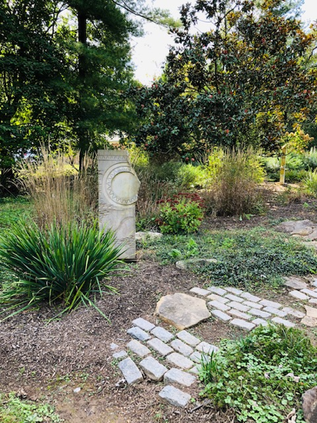
Has it happened to you after you’ve written a story, whether as a poem, essay, or scene, that something isn’t quite right about the form the story takes? This happens to me all the time. I find repurposing the story, turning the story into a poem or the essay into a scene with dialogue, tearing the narrative apart, selecting, cutting, reshaping sends me deeper into telling the story I want to tell.
On a recent field trip to Alden Farms in Beallesville, MD, a small group of writers and myself met the sculptor, David Therriault, and heard about his process of turning repurposed stone into sculptured pieces. David uses stones, “stolen, asked to change, ripped, chopped, moved, and piled for consumption” and retells their stories. In his workshop, David imagines new lives for stones and found metals, and with a nod to ancient cultures, creates pieces to adorn his garden. We wandered that day in the sun, mesmerized by the stones which whispered stories, both ancient and new.
Artists are always looking at other ways to tell the story. It’s difficult and maybe never possible to get it just right, to tell the truth of the story, but we try. I remember seeing a film of the novelist, Eudora Welty, as she cut apart her typed drafts, (before the word processing days), paragraph by paragraph, line by line at times, and with straight pins fastened them together in new patterns, aiming for a new story. All artists, published or not, practice this. At a gathering of writers, a poet friend and I talked together of how we spent the summer months revising, making something new out of the original poems. A seamstress buys sample wedding dresses and refashions them, a gardener, never satisfied with the present, always looks to the next season.
We write to make the pleasing music. Just as David’s stones, we are influenced by wind, light and dark, by rain. In his book, You Must Revise Your Life William Stafford acclaims, “Language changes, you change, the light changes.” In repurposing, you might find yourself closer to telling the story you envision. A truck loaded with stones, is just a truck with stones, until an artist desires it.
Has it happened to you after you’ve written a story, whether as a poem, essay, or scene, that something isn’t quite right about the form the story takes? This happens to me all the time. I find repurposing the story, turning the story into a poem or the essay into a scene with dialogue, tearing the narrative apart, selecting, cutting, reshaping sends me deeper into telling the story I want to tell.
On a recent field trip to Alden Farms in Beallesville, MD, a small group of writers and myself met the sculptor, David Therriault, and heard about his process of turning repurposed stone into sculptured pieces. David uses stones, “stolen, asked to change, ripped, chopped, moved, and piled for consumption” and retells their stories. In his workshop, David imagines new lives for stones and found metals, and with a nod to ancient cultures, creates pieces to adorn his garden. We wandered that day in the sun, mesmerized by the stones which whispered stories, both ancient and new.
Artists are always looking at other ways to tell the story. It’s difficult and maybe never possible to get it just right, to tell the truth of the story, but we try. I remember seeing a film of the novelist, Eudora Welty, as she cut apart her typed drafts, (before the word processing days), paragraph by paragraph, line by line at times, and with straight pins fastened them together in new patterns, aiming for a new story. All artists, published or not, practice this. At a gathering of writers, a poet friend and I talked together of how we spent the summer months revising, making something new out of the original poems. A seamstress buys sample wedding dresses and refashions them, a gardener, never satisfied with the present, always looks to the next season.
We write to make the pleasing music. Just as David’s stones, we are influenced by wind, light and dark, by rain. In his book, You Must Revise Your Life William Stafford acclaims, “Language changes, you change, the light changes.” In repurposing, you might find yourself closer to telling the story you envision. A truck loaded with stones, is just a truck with stones, until an artist desires it.
 RSS Feed
RSS Feed